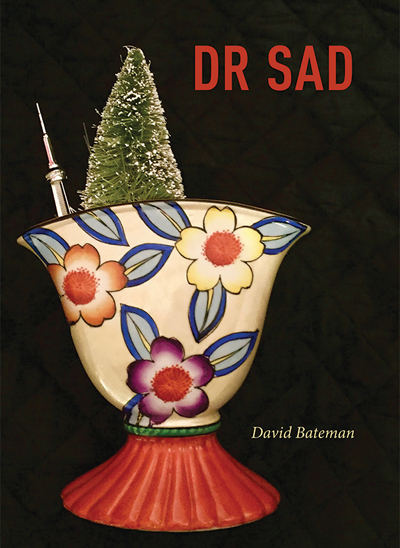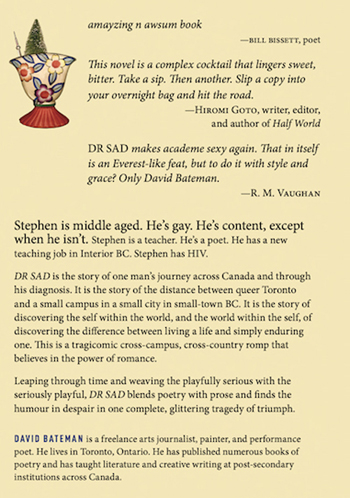Review of Dr David Bateman’s Dr SAD
Kathleen Reichelt
March 2021
The stories we tell sometimes must sit on a shelf. Away from the possibility of being broken, until we have a chance to document the precious events that shape our fragile lives. The vase that adorns the cover of David Bateman’s recently released novel DR SAD embodies this idea, and is one of the many carefully placed images the poet-as-novelist has inserted into this work of art.
The story begins on Christmas morning with a child opening presents in the presence of two loving parents and a family friend, our protagonist Stephen. There is a book Stephen gave to the child that at first goes unnoticed by the parents, until the story, within this story, opens the pages of history and questions whose story is being told. Details written with a keen eye such as describing two fathers as white, and not assuming the outdated “neutral”, would not have been written when Stephen was a boy. This is where we start.
Travelling between time and two sides of the country, DR SAD is a story of a middle aged gay poet and teacher who shares his time between queer Toronto and a small-town city in BC. Thankfully there is little time spent describing the landscape, with the author instead focusing on the characters who are both people and objects. In many ways the characters and objects signify the poetic stages of the protagonist, as much as being fully developed characters on their own or works of art embodied with their own histories.
As the story moves towards the life changing news of Stephen testing HIV positive, and the poignant telephone call with the naive messenger from Canada’s Health system, we come to know the protagonist more deeply through the people he knows, or doesn’t really know, interacts with and describes. The masked man, the teacher’s young student, the friend who drinks and waltzes the furniture aisles of Canadian Tire noting the history of a designer chair that started off in singular fame before becoming a reproduction in a sea of reproductions, and plastic.
In contrast, Stephen writes poetry and gives lessons. He compares kitsch throws found in Value Village with limerick form. He refers to William Carlos Williams, whose influences are felt in many gorgeously written descriptions of all that is beautiful in the ordinary ways of wheelbarrows and bathhouses. Bateman lovingly describes bodies that grow old, bodies in darkened rooms, but not too dark as to suggest anything other than the beauty of naked men exchanging poetry without words. In contrast is youth’s resistance to a thesaurus and the men hiding from themselves and their girlfriends in a fictional world inside a real world that may have public Pride parades with prime ministers in attendance but continues here and elsewhere to be a precarious right of sexual freedom. Current events around the world remind us that what has been earned, which should never have needed to be earned in the first place, can be taken away like land, like the names of places, like language and its poetry, and treaties broken. Always under threat by the regime of uniformity erasing culture, identity and individuality.
Language, objects, performance, art, all threatened by erasure.
Early in the book there is a beautiful scene in Stephen’s bathroom mirror where he first utters the word opps, and then repeats it over and over not in an angry or frightened way, more akin to a joyful, head-splitting catharsis inspired by some of his theatre training, and based on the theories of people like Artaud, Grotowski, Peter Brook, Augusto Boal, Lily Tomlin, Joan Rivers, and Miss Piggy. (page 35) It is here that I am reminded of my first encounter with the author, David Bateman, as audience in a black box collectively run theatre in Peterborough, Ontario in the early 1990s. David was rolling around the wooden floors on roller skates, in a space that used to be a coffin factory, while making salads and addressing directly the audience with his stories. What David has done with DR SAD is not so dissimilar, though there is a more serious undertone now, thirty years later.
The vase on the cover has a story too. Photographed with the top of a plastic Christmas tree and a kitschy toy-sized CN tower that looks almost like a needle. Like an inoculation in waiting.
The reader is treated to rich imagery, side splitting humour, compelling stories, and David Bateman’s beautiful poetry. Please buy this book and share it with lovers of words. It’s a wonderful way to spend time with a beautiful dreamer, a poet, performer and friend of art.
Dr SAD is available from University of Calgary Press →
David Bateman has a PhD in English literature with a specialization in creative writing from the University of Calgary. He is currently a freelance arts journalist, painter, and performance poet who lives in Toronto. He has editing collections including Patricia Wilson’s Missing From the Bunker/Slouching Towards Womanhood and a series of essay on the work of Sky Gilbert entitled Compulsive Acts (Guernica Editions, Toronto). He has taught literature and creative writing at post-secondary institutions across Canada, including Trent University (Peterborough and Oshawa), University of Calgary, OCAD University (Toronto), ECIAD University (Emily Carr, Vancouver) and Thompson Rivers University (Kamloops). His poetry collections, all from Frontenac House Press (Calgary), include Invisible Foreground, Impersonating Flowers, ‘tis pity, Designation Youth. His collaborative long poems include “Wait Until Later Afternoon” with Hiromi Goto (Frontenac House Press) and “Pause” with Naomi Beth Wakan (Bevalia Press). His collection of short stories and creative non-fiction entitled A Mad Bent Diva: A Collection of LIfe Affirming Death Threats, Vignettes, and Epithets was published by HIdden Brook Press in 2017. And he is, by degree, a mad bent diva, proven by the serendipitous fact that his name is an anagram for A Mad Bent Diva. He discovered this term of endearment in his forties at a magnificent poetry festival on Gabriola Island, and is forever grateful to Hilary Peach and Jacob Chaos for bringing this to his attention.
◊
For more reviews, interiews & essays by Kathleen Reichelt on Arteidolia→


